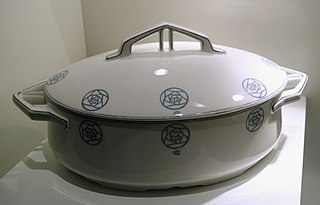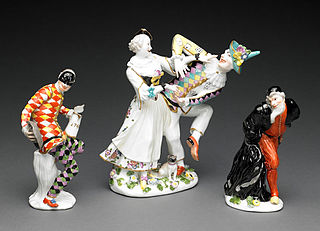 W
WArzberg is the trademark of a German manufacturer of porcelain, founded in 1887 in Arzberg, Bavaria. Its fame is largely based on designs by Hermann Gretsch, whose Form 1382, conceived in 1931 and based on Bauhaus principles, marks a milestone in modern design; Form 1382 is still produced today, and sold worldwide. Hutschenreuther AG, holder of the Arzberg trademark since 1972, was dissolved in 2000 and the trademark was taken over by SKV-Porzellan-Union GmbH, founded in 1993 by the porcelain companies Schirnding, Kronester and Johann Seltmann Vohenstrauß. In 2004, SKV-Porzellan-Union GmbH was renamed Arzberg-Porzellan GmbH. In 2003, the company had approximately 250 employees. Since 2000, however, the headquarters of the company holding the trademark Arzberg are located in Schirnding, where production took place. After 10 years Arzberg GmbH announced its insolvency. Today the trademark is owned by Rosenthal porcelain.
 W
WSächsische Porzellanmanufaktur Dresden, often known in English simply as Dresden Porcelain, is a porcelain factory in Freital near Dresden, which was founded in 1872 and still keeps alive the long tradition of European porcelain art. Since 1902, Dresden Porcelain has a blue "SP Dresden" registered trademark.
 W
WThe Frankenthal Porcelain Factory was one of the greatest porcelain manufacturers of Germany and operated in Frankenthal in the Rhineland-Palatinate between 1755 and 1799. From the start they made hard-paste porcelain, and produced both figurines and dishware of very high quality, somewhat reflecting in style the French origin of the business, especially in their floral painting. Initially they were a private business, but from 1761 were owned by the local ruler, like most German porcelain factories of the period.
 W
WThe Porcelain factory Fraureuth Joint-stock company in Fraureuth was one of the biggest and best standard porcelain factories of the German Reich.
 W
WHB-Werkstätten für Keramik GmbH in the Brandenburg district of Marwitz were founded by Hedwig Bollhagen (1907–2001) and Heinrich Schild (1895–1978). Hedwig Bollhagen remained Artistic Director until shortly before her death in 2001.
 W
WMargarete Heymann, also known as Margarete Heymann-Löbenstein, Margarete Heymann-Marks, and Grete Marks, was a German ceramic artist of Jewish origin and a Bauhaus student. In 1923 she founded the Haël Workshops for Artistic Ceramics at Marwitz that she had to close in 1933 and settled in Jerusalem. She moved to Britain in 1936 and continued her work, becoming world famous as “Greta Pottery”. Her finest work is considered to be from her working period in Germany.
 W
WHutschenreuther is the name of a German family that established the production of porcelain in northern Bavaria, starting in 1814.
 W
WThe Lichte porcelain (GmbH) was founded 1822 in Lichte, Thuringian Highlands.
 W
WMeissen porcelain or Meissen china was the first European hard-paste porcelain. Early experiments were done in 1708 by Ehrenfried Walther von Tschirnhaus. After his death that October, Johann Friedrich Böttger continued von Tschirnhaus's work and brought this type of porcelain to the market, financed by Augustus the Strong, King of Poland and Elector of Saxony. The production of porcelain in the royal factory at Meissen, near Dresden, started in 1710 and attracted artists and artisans to establish, arguably, the most famous porcelain manufacturer known throughout the world. Its signature logo, the crossed swords, was introduced in 1720 to protect its production; the mark of the swords is reportedly one of the oldest trademarks in existence. In English Dresden porcelain was once the usual term for these wares, especially the figures; this is because Meissen is geographically not far from Dresden which is the Saxon capital.
 W
WThe Nymphenburg Porcelain Manufactory is located at the Nördliche Schloßrondell in one of the Cavalier Houses in front of the Nymphenburg Palace in Munich, Germany, and since its establishment in 1747 has produced porcelain of high quality. It is one of the last porcelain producers in the world where every single part is made entirely by hand.
 W
WRosenthal GmbH is a German manufacturer of porcelain products and other household goods. The original firm was founded in 1879 in Selb, Bavaria. Since 2009, Rosenthal has been owned by the Italian company Sambonet Paderno Industrie.
 W
WThe Royal Porcelain Factory in Berlin, also known as the Royal Porcelain Manufactory Berlin and whose products are generally called Berlin porcelain, was founded in 1763 by King Frederick II of Prussia. Its actual origins, however, lie in three private enterprises which, under crown patronage, were trying to establish the production of "white gold" in Berlin from the mid-18th century onwards.
 W
WVilleroy & Boch is a German manufacturer of ceramics, with the company headquarters located in Mettlach, Saarland.
 W
WVolkstedt porcelain manufactury sited in Rudolstadt, Thuringia, Germany, was the earliest porcelain manufactory in Thuringia. It was in business as Aelteste Volkstedter Porzellanmanufaktur, the "Oldest Volkstedt Porcelain Manufactory", which was integrated into the VEB Vereinigte Zierporzellanwerke Lichte, which in turn formed part of the Kombinat Feinkeramik Kahla.
 W
WWaechtersbach ceramics is a German ceramics manufacturer in Brachttal near Wächtersbach, which was founded in 1832 by the Prince Adolf of Ysenburg and Büdingen of Isenburg-Wächtersbach. It is a registered company since 4 July 2003.
 W
WWallendorfer Porzellan or Wallendorf Porcelain is a porcelain manufacturing company which has been in operation since 1764 in Lichte (Wallendorf) in the Thuringian Highlands. Wallendorf is one of the oldest porcelain trademarks in Germany and the whole of Europe.